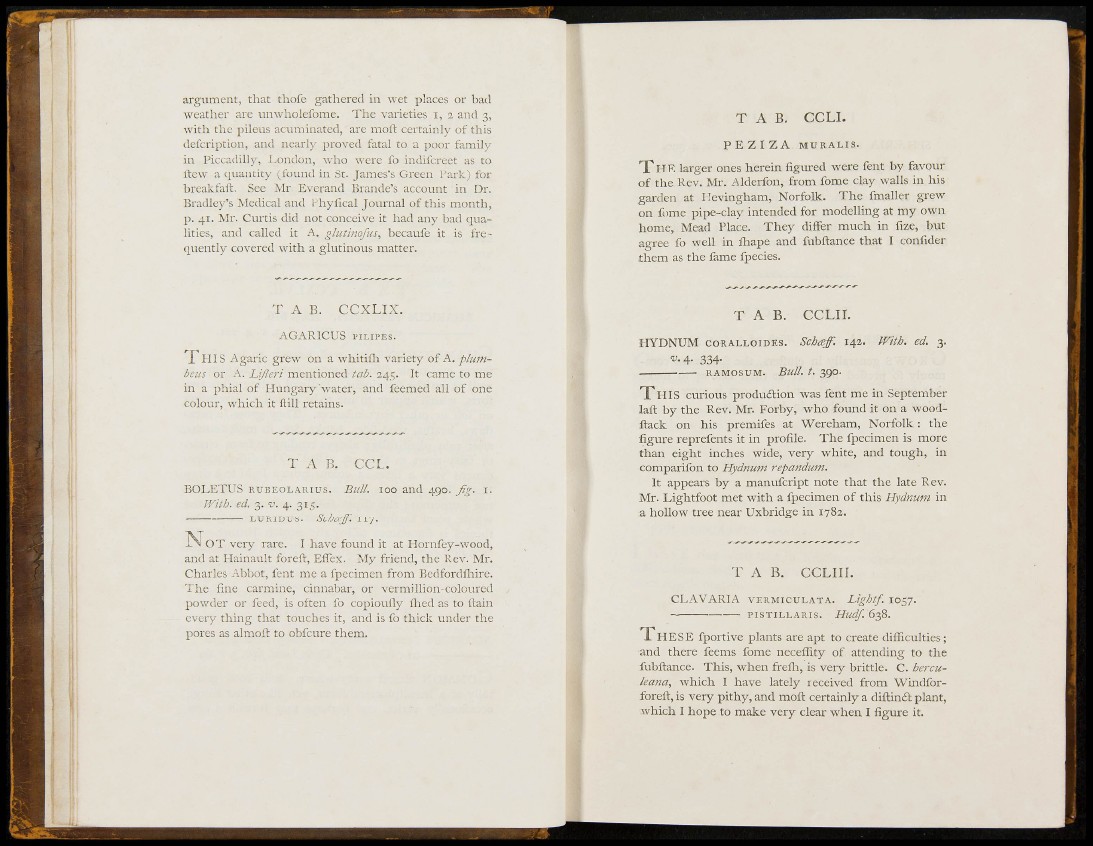
m
P i argument, that tliofe gathered in wet places or bad
weather are unwholefome. The varieties i, a and 3,
with the piJeus acuminated, are moft certainly of this
defcription, and nearly proved fatal to a poor family
in Piccadilly, I.ondon, who were fo indifcreet as to
ftew a quantity (found in St. James's Green Park) for
breakfaft. See Mr Everand Brande's account in Dr.
Bradley's Medical and Fhyllcal Journal of this month,
p. 41. Mr. Curtis did not conceive it had any bad qualities,
and called it A. glutinofus, becaufe it is frequently
covered with a glutinous matter.
T A B . CCLI.
P E Z I Z A MURALIS.
T h e larger ones herein figured were fent by favour
of the Rev. Mr. Alderfon, from fome clay walls in his
garden at Ilevingham, Norfolk. The fmaller grew
on fome pipe-clay intended for modelling at my own
home, Mead Place. They differ much in fize, but
agree fo %vell in fliape and fubftance that I confider
them as the fame fpecies.
T A B. CCXLIX.
AGARICUS PILIPES.
X"hIS Agaric grew on a whitiili variety of A. fluinheus
or A. Lijleri mentioned tab. 245. It came to me
in a phial of Hungary'water, and feemed all of one
colour, which it ftill retains.
T A B. CCL.
BOLETUS RUBEOLAUIUS. Bull. 100 and 490, fig. i.
With. ed. 3. V. 4. 315.
LURiDUs. Schifff. 117.
N O T very rare. I have found it at Hornfey-wood,
and at Hainault foreft, Effex. My friend, the Rev. Mr.
Charles Abbot, fent me a fpecimen from Bedfordfliire.
The fine carmine, cinnabar, or vermillion-coloured
powder or feed, is often fo copioufly flied as to ftain
every thing that touches it, and is fo thick under the
pores as almoft to obfcure them.
T A B . CCLII.
HYDNUM CORALLOIDES. Schaff. 142. With.
•y.4. 334.
RAMOSUM. Bull. t. 390.
T H I S curious produaion was fent me in September
lafl: by the Rev. Mr. Forby, who found it on a woodftack
on his premifes at Wereham, Norfolk: the
figure reprefents it in profile. The fpecimen is more
than eight inches wide, very white, and tough, in
comparifon to Hydnum repandum.
It appears by a manufcript note that the late Rev.
Mr. Lightfoot met with a fpecimen of this Hydnum in
a hollow tree near Uxbridge in 1782.
T A B. CCLIII.
CLAVARIA VERMICULATA. Lightf. 1057.
PISTILLARIS. Hudf.60jii.
1 HESE fportive plants are apt to create difliculties;
and there feems fome neceffity of attending to the
fubftance. This, when frefli, is very brittle. C. herculeana,
which I have lately received from Windforforeft,
is very pithy, and moft certainly a diilintSt plant,
which I hope to make very clear when I figure it.